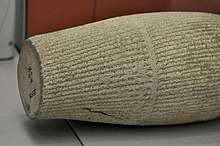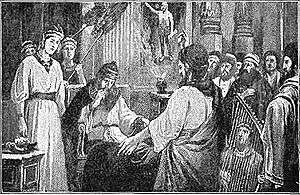Nebuchadnezzar II
| Nabû-kudurri-usur | |
|---|---|
| King of Babylon | |
 An engraving with a royal inscription of Nebuchadnezzar II. Anton Nyström, 1901.[1] | |
| Reign | c. 605 – c. 562 BC |
| Predecessor | Nabopolassar |
| Successor | Amel-Marduk |
| Born | c. 634 BC |
| Died | c. 562 BC (aged 71–72) |
| Spouse | Amytis of Media |
| House | Chaldean |
| Father | Nabopolassar |
Nebuchadnezzar II (/ˌnɛbjʊkədˈnɛzər/; from Akkadian 𒀭𒀝𒆪𒁺𒌨𒊑𒋀 dNabû-kudurri-uṣur; Hebrew: נְבוּכַדְנֶאצַּר, Modern Nəvūkádne’ṣar, Tiberian Neḇukáḏné’ṣār), meaning "O god Nabu, preserve/defend my firstborn son") was king of Babylon c. 605 BC – c. 562 BC, the longest and most powerful reign of any monarch in the Neo-Babylonian empire.[2][3]
Life


Nebuchadnezzar was the eldest son and successor of Nabopolassar, an Assyrian official who rebelled and established himself as king of Babylon in 620 BC; the dynasty he established ruled until 539 BC, when the Neo-Babylonian Empire was conquered by Cyrus the Great.[4][5] Nebuchadnezzar is first mentioned in 607 BC, during the destruction of Babylon's arch-enemy Assyria, at which point he was already crown prince.[6] In 605 BC he and his ally Cyaxares, ruler of the Medes and Persians, led an army against the Assyrians and Egyptians, who were then occupying Syria, and in the ensuing Battle of Carchemish, Necho II was defeated and Syria and Phoenicia were brought under the control of Babylon.[7]
Government in throne
Nabopolassar died in August 605 BC, and Nebuchadnezzar returned to Babylon to ascend the throne.[8] For the next few years, his attention was devoted to subduing his eastern and northern borders, and in 595/4 BC there was a serious but brief rebellion in Babylon itself.[9] In 594/3 BC, the army was sent again to the west, possibly in reaction to the elevation of Psammetichus II to the throne of Egypt.[9] King Zedekiah of Judah attempted to organize opposition among the small states in the region but his capital, Jerusalem, was taken in 587 BC (the events are described in the Bible's Books of Kings and Book of Jeremiah).[10]
In the following years, Nebuchadnezzar incorporated Phoenicia and the former Assyrian provinces of Cilicia (southwestern Anatolia) into his empire and may have campaigned in Egypt.[11]
In his last years, Nebuchadnezzar seems to have begun behaving irrationally, "pay[ing] no heed to son or daughter," and was deeply suspicious of his sons.[12] The kings who came after him ruled only briefly and Nabonidus, apparently not of the royal family, was overthrown by the Persian conqueror Cyrus the Great less than twenty-five years after Nebuchadnezzar's death.
The ruins of Nebuchadnezzar's Babylon are spread over two thousand acres, forming the largest archaeological site in the Middle East.[13] He enlarged the royal palace (including in it a public museum, possibly the world's first), built and repaired temples, built a bridge over the Euphrates, and constructed a grand processional boulevard (the Processional Way) and gateway (the Ishtar Gate) lavishly decorated with glazed brick.[14] Each spring equinox (the start of the New Year), the god Marduk would leave his city temple for a temple outside the walls, returning through the Ishtar Gate and down the Processional Way, paved with colored stone and lined with molded lions, amidst rejoicing crowds.[12]
Portrayal in the Bible

The Babylonian king's two sieges of Jerusalem (in 597 and 587 BCE) are depicted in 2 Kings 24–25. The Book of Jeremiah calls Nebuchadnezzar the "destroyer of nations" (Jer. 4:7) and gives an account of the second siege of Jerusalem (587 BC) and the looting and destruction of the First Temple (Jer. 39:1–10; 52:1–30).
Nebuchadnezzar is an important character in the Book of Daniel, a collection of legendary tales and visions dating from the 2nd century BC.[15] Daniel 1 introduces Nebuchadnezzar as the king who takes Daniel and other Hebrew youths into captivity in Babylon, there to be trained in "the learning and the tongue of the Chaldeans". In Nebuchadnezzar's second year, Daniel interprets the king's dream of a huge image as God's prediction of the rise and fall of world powers, starting with Nebuchadnezzar's kingdom (Daniel 2). Nebuchadnezzar twice admits the power of the God of the Hebrews: first after Yahweh saves three of Daniel's companions from a fiery furnace (Daniel 3) and secondly after Nebuchadnezzar himself suffers a humiliating period of madness, as Daniel predicted (Daniel 4). The consensus among modern scholars is that the book of Daniel is historical fiction.[16][17][18]
Portrayal in medieval Muslim sources
According to Ali ibn Sahl Rabban al-Tabari, Nebuchadnezzar, whose Persian name was Bukhtrashah, was of Persian descent, from the progeny of Jūdharz; however, modern scholars are unanimous that he was either a native Mesopotamian (Assyrian-Babylonian) or a Chaldean. Some medieval writers erroneously believed he lived as long as 300 years.[19] While much of what is written about Nebuchadnezzar depicts a ruthless warrior, some texts describe a ruler who was concerned with both spiritual and moral issues in life and was seeking divine guidance.[20]
Nebuchadnezzar was seen as a strong, conquering force in Islamic texts and historical compilations, like Al-Tabari. The Babylonian leader used force and destruction to grow an empire. He conquered kingdom after kingdom, including Phoenicia, Philistia, Judah, Ammon, Moab, and more.[21] The most notable events that Tabari’s collection focuses on is the destruction of Jerusalem.[19]
.jpg)
See also
References
- ↑ Anton Nyström, Allmän kulturhistoria eller det mänskliga lifvet i dess utveckling, bd 2 (1901)
- ↑ Freedman 2000, p. 953.
- ↑ "Nebuchadnezzar II". ancient.eu. Retrieved December 22, 2017.
- ↑ Bertman 2005, p. 95.
- ↑ Oates 1997, p. 162.
- ↑ Wiseman 1991a, p. 182.
- ↑ Wiseman 1991a, p. 182–183.
- ↑ Wiseman 1991a, p. 183.
- 1 2 Wiseman 1991a, p. 233.
- ↑ Wiseman 1991a, p. 233–234.
- ↑ Wiseman 1991a, p. 235–236.
- 1 2 Foster 2009, p. 131.
- ↑ Arnold 2005, p. 96.
- ↑ Bertman 2005, p. 96.
- ↑ Collins 2002, p. 2.
- ↑ Collins 1999, p. 219.
- ↑ Redditt 2008, p. 180.
- ↑ Collins 1984, p. 41: "Conversely, most critical scholars take for granted that the genre is not History."
- 1 2 Ṭabarī, Muḥammad Ibn-Ǧarīr Aṭ- (1987). The History of Al-Tabarī. State Univ. of New York Pr. pp. 43–70.
- ↑ Wiseman, D.J. (1985). Nebuchadrezzar and Babylon. Oxford.
- ↑ Tabouis, G.R. (1931). Nebuchadnezzar. Whittlesey House. p. 3.
Bibliography
- Arnold, Bill T. (2005). Who Were the Babylonians?. Brill. ISBN 9004130713.
- Bertman, Stephen (2005). Handbook to Life in Ancient Mesopotamia. Oxford University Press. ISBN 978-0-19-518364-1.
- Cline, Eric H.; Graham, Mark W. (2011). Ancient Empires: From Mesopotamia to the Rise of Islam. Cambridge University Press. ISBN 978-0-521-88911-7.
- Dalley, Stephanie (1998). The Legacy of Mesopotamia. Oxford University Press. ISBN 978-0-19-814946-0.
- Foster, Benjamin Read; Foster, Karen Polinger (2009). Civilizations of Ancient Iraq. Princeton University Press. ISBN 0-691-13722-6.
- Freedman, David Noel (2000). "Nebuchadnezzar". In Freedman, David Noel; Myers, Allen C. Eerdmans Dictionary of the Bible. Eerdmans. ISBN 9789053565032.
- Lee, Wayne E. (2011). Warfare and Culture in World History. NYU Press. ISBN 978-0-8147-5278-4.
- Oates, J (1991). "The Fall of Assyria (635–609 BC)". In Boardman, John; Edwards, I. E. S. The Cambridge Ancient History, Volume III Part II. Cambridge University Press. ISBN 978-0-521-22717-9.
- Sweeney, Marvin A. (1996). Isaiah 1–39: With an Introduction to Prophetic Literature. Eerdmans. ISBN 978-0-8028-4100-1.
- Wiseman, D.J. (1991a). "Babylonia 605–539 BC". In Boardman, John; Edwards, I. E. S. The Cambridge Ancient History, Volume III Part II. Cambridge University Press. ISBN 978-0-521-22717-9.
- Wiseman, D.J. (1991b). Nebuchadrezzar and Babylon: The Schweich Lectures of The British Academy 1983. OUP/British Academy. ISBN 978-0-19-726100-2.
- Bandstra, Barry L. (2008). Reading the Old Testament: An Introduction to the Hebrew Bible. Wadsworth Publishing Company. ISBN 0-495-39105-0.
- Bar, Shaul (2001). A letter that has not been read: dreams in the Hebrew Bible. Cincinnati: Hebrew Union College Press. ISBN 978-0-87820-424-3.
- Boyer, Paul S. (1992). When Time Shall Be No More: Prophecy Belief in Modern American Culture. Harvard University Press. ISBN 0-674-95129-8.
- Brettler, Mark Zvi (2005). How To Read the Bible. Jewish Publication Society. ISBN 978-0-8276-1001-9.
- Carroll, John T. (2000). "Eschatology". In Freedman, David Noel; Myers, Allen C. Eerdmans Dictionary of the Bible. Eerdmans. ISBN 9789053565032.
- Cohn, Shaye J.D. (2006). From the Maccabees to the Mishnah. Westminster John Knox Press. ISBN 978-0-664-22743-2.
- Collins, John J. (1999). "Daniel". In Van Der Toorn, Karel; Becking, Bob; van der Horst, Pieter Willem. Dictionary of Deities and Demons in the Bible. Eerdmans. ISBN 978-0-8028-2491-2.
- Collins, John J. (1984). Daniel: With an Introduction to Apocalyptic Literature. Eerdmans. ISBN 978-0-8028-0020-6.
- Collins, John J. (1993). Daniel. Fortress. ISBN 978-0-8006-6040-6.
- Collins, John J. (1998). The Apocalyptic Imagination: An Introduction to Jewish Apocalyptic Literature. Eerdmans. ISBN 978-0-8028-4371-5.
- Collins, John J. (2001). Seers, Sibyls, and Sages in Hellenistic-Roman Judaism. Brill. ISBN 978-0-391-04110-3.
- Collins, John J. (2002). "Current Issues in the Study of Daniel". In Collins, John J.; Flint, Peter W.; VanEpps, Cameron. The Book of Daniel: Composition and Reception. Brill. ISBN 9004116753.
- Collins, John J. (2003). "From Prophecy to Apocalypticism: The Expectation of the End". In McGinn, Bernard; Collins, John J.; Stein, Stephen J. The Continuum History of Apocalypticism. Continuum. ISBN 978-0-8264-1520-2.
- Collins, John J. (2013). "Daniel". In Lieb, Michael; Mason, Emma; Roberts, Jonathan. The Oxford Handbook of the Reception History of the Bible. Oxford UNiversity Press. ISBN 978-0-19-164918-9.
- Crawford, Sidnie White (2000). "Apocalyptic". In Freedman, David Noel; Myers, Allen C. Eerdmans Dictionary of the Bible. Eerdmans. ISBN 9789053565032.
- Cross, Frank Leslie; Livingstone, Elizabeth A. (2005). The Oxford Dictionary of the Christian Church. Oxford University Press. ISBN 978-0-19-280290-3.
- Davies, Philip (2006). "Apocalyptic". In Rogerson, J. W.; Lieu, Judith M. The Oxford Handbook of Biblical Studies. Oxford Handbooks Online. ISBN 978-0-19-925425-5.
- DeChant, Dell (2009). "Apocalyptic Communities". In Neusner, Jacob. World Religions in America: An Introduction. Westminster John Knox Press. ISBN 978-1-61164-047-2.
- Doukhan, Jacques (2000). Secrets of Daniel: Wisdom and Dreams of a Jewish Prince in Exile. Review and Herald Pub Assoc. ISBN 978-0-8280-1424-3.
- Dunn, James D.G. (2002). "The Danilic Son of Man in the New Testament". In Collins, John J.; Flint, Peter W.; VanEpps, Cameron. The Book of Daniel: Composition and Reception. Brill. ISBN 0-391-04128-2.
- Godden, Malcolm (2013). "Biblical Literature" The Old Testament". In Godden and, Malcolm; Lapidge, Michael. The Cambridge Companion to Old English Literature. Cambridge University Press. ISBN 978-1-107-46921-1.
- Grabbe, Lester L. (2002a). Judaic Religion in the Second Temple Period: Belief and Practice from the Exile to Yavneh. Routledge. ISBN 978-0-203-46101-3.
- Grabbe, Lester L. (2002b). "A Dan(iel) For All Seasons". In Collins, John J.; Flint, Peter W.; VanEpps, Cameron. The Book of Daniel: Composition and Reception. Brill. ISBN 9004116753.
- Grabbe, Lester L. (2010). An Introduction to Second Temple Judaism: History and Religion of the Jews in the Time of Nehemiah, the Maccabees, Hillel, and Jesus. Continuum. ISBN 978-0-567-55248-8.
- Hammer, Raymond (1976). The Book of Daniel. Cambridge University Press. ISBN 978-0-521-09765-9.
- Harrington, Daniel J. (1999). Invitation to the Apocrypha. Eerdmans. ISBN 978-0-8028-4633-4.
- Hill, Andrew E. (2009). "Daniel". In Garland, David E.; Longman, Tremper. Daniel—Malachi. Zondervan. ISBN 978-0-310-59054-5.
- Hill, Charles E. (2000). "Antichrist". In Freedman, David Noel; Myers, Allen C. Eerdmans Dictionary of the Bible. Eerdmans. ISBN 9789053565032.
- Horsley, Richard A. (2007). Scribes, Visionaries, and the Politics of Second Temple Judea. Presbyterian Publishing Corp. ISBN 978-0-664-22991-7.
- Knibb, Michael (2002). "The Book of Daniel in its Context". In Collins, John J.; Flint, Peter W.; VanEpps, Cameron. The Book of Daniel: Composition and Reception. Brill. ISBN 9004116753.
- Levine, Amy-Jill (2010). "Daniel". In Coogan, Michael D.; Brettler, Marc Z.; Newsom, Carol A. The new Oxford annotated Bible with the Apocryphal/Deuterocanonical books : New Revised Standard Version. Oxford University Press. ISBN 978-0-19-937050-4.
- Lucas, Ernest C. (2005). "Daniel, Book of". In Vanhoozer, Kevin J.; Bartholomew, Craig G.; Treier, Daniel J. Dictionary for Theological Interpretation of the Bible. Baker Academic. ISBN 978-0-8010-2694-2.
- Matthews, Victor H.; Moyer, James C. (2012). The Old Testament: Text and Context. Baker Books. ISBN 978-0-8010-4835-7.
- McDonald, Lee Martin (2012). Formation of the Bible: the Story of the Church's Canon. Peabody, MA: Hendrickson Publishers. p. 57. ISBN 978-1-59856-838-7. Retrieved 22 July 2014.
- Miller, Steven R. (1994). Daniel. B&H Publishing Group. ISBN 978-0-8054-0118-9.
- Niskanen, Paul (2004). The Human and the Divine in History: Herodotus and the Book of Daniel. Continuum. ISBN 978-0-567-08213-8.
- Provan, Iain (2003). "Daniel". In Dunn, James D. G.; Rogerson, John William. Eerdmans Commentary on the Bible. Eerdmans. ISBN 978-0-8028-3711-0.
- Redditt, Paul L. (2009). Introduction to the Prophets. Eerdmans. ISBN 978-0-8028-2896-5.
- Reid, Stephen Breck (2000). "Daniel, Book of". In Freedman, David Noel; Myers, Allen C. Eerdmans Dictionary of the Bible. Eerdmans. ISBN 9789053565032.
- Rowland, Christopher (2007). "Apocalyptic Literature". In Hass, Andrew; Jasper, David; Jay, Elisabeth. The Oxford Handbook of English Literature and Theology. Oxford University Press. ISBN 978-0-19-927197-9.
- Ryken,, Leland; Wilhoit, Jim; Longman, Tremper (1998). Dictionary of Biblical Imagery. InterVarsity Press. ISBN 978-0-8308-6733-2.
- Sacchi, Paolo (2004). The History of the Second Temple Period. Continuum. ISBN 978-0-567-04450-1.
- Schwartz, Daniel R. (1992). Studies in the Jewish Background of Christianity. Mohr Siebeck. ISBN 978-3-16-145798-2.
- Seow, C.L. (2003). Daniel. Westminster John Knox Press. ISBN 978-0-664-25675-3.
- Schiffman, Lawrence H. (1991). From Text to Tradition: A History of Second Temple and Rabbinic Judaism. KTAV Publishing House. ISBN 978-0-88125-372-6.
- Spencer, Richard A. (2002). "Additions to Daniel". In Mills, Watson E.; Wilson, Richard F. The Deuterocanonicals/Apocrypha. Mercer University Press. ISBN 978-0-86554-510-6.
- Towner, W. Sibley (1984). Daniel. Westminster John Knox Press. ISBN 978-0-664-23756-1.
- VanderKam, James C. (2010). The Dead Sea Scrolls Today. Eerdmans. ISBN 978-0-8028-6435-2.
- VanderKam, James C.; Flint, Peter (2013). The meaning of the Dead Sea scrolls: their significance for understanding the Bible, Judaism, Jesus, and Christianity. HarperCollins. ISBN 978-0-06-224330-0.
- Waters, Matt (2014). Ancient Persia: A Concise History of the Achaemenid Empire, 550–330 BC. Cambridge University Press. ISBN 978-1-107-65272-9.
- Weber, Timothy P. (2007). "Millennialism". In Walls, Jerry L. The Oxford Handbook of Eschatology. Oxford University Press. ISBN 978-0-19-974248-6.
- Wesselius, Jan-Wim (2002). "The Writing of Daniel". In Collins, John J.; Flint, Peter W.; VanEpps, Cameron. The Book of Daniel: Composition and Reception. Brill. ISBN 0-391-04128-2.
External links
| Wikimedia Commons has media related to Nebuchadnezzar II. |
| Wikisource has the text of the 1879 American Cyclopædia article Nebuchadnezzar. |
- Inscription of Nabuchadnezzar. Babylonian and Assyrian Literature – old translation
- Nabuchadnezzar Ishtar gate Inscription
- Jewish Encyclopedia on Nebuchadnezzar
- Nebuchadnezzar II on Ancient History Encyclopedia
| Preceded by Nabopolassar |
King of Babylon 605 BC – 562 BC |
Succeeded by Amel-Marduk |